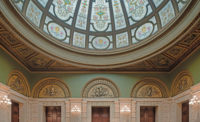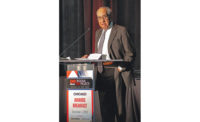A year after nearly 1,000 migrating birds were killed from striking exterior glass at Lakeside Center, an exhibition space at McCormick Place in Chicago, a $1.2-million project to install a bird-friendly pattern on windows, curtain wall and other exterior glass covering the size of two football fields was completed in September.
The film was manufactured by Toronto-based Feather Friendly Technologies. The installation, which took three months to complete, was done by NGS Films and Graphics of Canton, Ga. The application started in June and required temperatures to be above 50 degrees consistently for the product to properly adhere to the windows. Installers worked in two shifts, five days per week.
“There was a lot of staff and logistics involved in the installation and several lifts and boom trucks,” says Paul Groleau, vice president of Feather Friendly Technologies.
The film is applied and then removed, and the pattern of marks remains, says Groleau.
“[Removing the film] is for the durability and longevity of the product, which will last for 15 plus years,” he says.
The Metropolitan Pier and Exposition Authority (commonly known as McPier), which operates the center, pursued the window-film solution to minimize collisions based on recommendations from local, national and international bird and animal advocacy groups, including the U.S. Fish & Wildlife Service, Chicago Bird Collision Monitors and Never Collide.

Photo courtesy of the Metropolitan Pier and Exhibition Authority
“When we learned of the reported mass collision event last year, we knew that we needed to quickly make additional improvements to protect local and migratory birds as they pass McCormick Place,” says Larita Clark, CEO of McPier.
The film, which has a pattern that is not visible at a distance to human eyes, is visible to birds and helps them distinguish between open air and glass. For new construction, many architects specify a frit pattern that’s manufactured with the glass itself.
Brian Smith, assistant regional director for migratory birds for the wildlife service’s Midwest region, commended the authority for its response ahead of this year’s fall migratory bird season.
“MPEA leadership was open to suggestions, and they were transparent with us as they implemented swift and significant changes to their lighting and existing windows to reduce risk to birds in future migratory seasons,” he says.
McPier also reaffirmed its commitment to the Lights Out Chicago program, which requires buildings to turn off their lights when they are unoccupied. It also began shutting off unnecessary external lights that may attract wildlife and enacted a policy requiring drapes to be closed overnight at Lakeside Center to prevent light from escaping.
Julian Siggers, president and CEO of Chicago’s Field Museum of Natural History, which has documented bird collisions at Lakeside Center for more than four decades, expects the film to reduce the number of bird collisions.
“We would expect to see a measurable reduction in those numbers this fall migration season as a result of the new window treatment and policies MPEA has enacted,” he says. Smith says McPier’s efforts “will provide a model for buildings to reduce bird collisions all over Chicago and the world.”




